Abstract
In response to the growing industrial demand for ultra-high-purity gold, a vacuum distillation-assisted hydrometallurgical process is developed in this study for the industrial-scale production of 99.999% pure (5N) gold from crude Au–Ag alloy feedstocks. This integrated approach combines vacuum distillation, aqua regia dissolution, solvent extraction, and in situ reduction. An alloy containing approximately 56.47 wt% Au and 43.06 wt% Ag was first vacuum distilled, yielding a pre-enriched alloy with 94.76 wt% Au and less than 5.17 wt% Ag. The enriched Au alloy was subjected to aqua regia dissolution, solvent extraction, and Na2SO3-assisted reduction. The influence of the liquid-to-solid ratio, settling time, phase ratio, extraction time, and centrifugation speed on gold purity and recovery was systematically investigated. Under optimized conditions, the process achieved 99.999% purity and over 99.5% overall recovery, meeting the GB/T 25933-2010 standard. The use of Na2SO3 as a combined reducing and stripping agent simplified the operation, lowered reagent consumption, and improved environmental compatibility. This method provides a scalable, cost-effective, and environmentally friendly alternative to conventional refining techniques and is suitable for advanced manufacturing applications.
1. Introduction
With the rapid development of the gold industry and adjustments in national economic policies involving gold, gold has gradually entered market circulation as a special commodity, leading to shifts in its economic role and applications, specifically a decline in its monetary function and an expansion in its industrial and high-tech uses [1,2]. Moreover, as market competition intensifies and quality requirements increase, traditional smelting processes can no longer meet the demand for high-purity gold. To enhance product value, domestic enterprises have continuously improved refining technologies to achieve higher purity levels of gold [3,4]. High-purity gold refers to gold products with a total impurity mass fraction not exceeding 10 ppm and a gold content of at least 99.999%; this gold is labeled AU99999 (GB/T 25933-2010 [5]). Due to its excellent workability, high-purity gold can be plated onto metals, ceramics, or glass and is suitable for welding and forging under pressure, making it widely applicable in modern high-tech industries such as electronics, communications, aerospace, chemicals, and medical devices [6,7]. For instance, gold is used in semiconductor circuits and integrated circuit chips (owing to its high electrical and thermal conductivity), medical equipment (owing to its biocompatibility), and precision aerospace electronics (owing to its corrosion resistance and conductivity). Additionally, high-purity gold is often used to prepare standard solutions for chemical analysis. In recent years, with the rise in China’s high-end manufacturing sector, the demand for AU99999 has increased at an annual rate of 20–80%.
Common gold refining technologies include pyrometallurgy, chemical refining, electrolysis, and solvent extraction [8,9,10]. Pyrometallurgy relies on differences in the physical and chemical properties (e.g., melting point, oxidizability, volatility) between gold and impurities at high temperatures, separating them through oxidation, slagging, volatilization, or selective reactions. Although effective for certain feedstocks, pyrometallurgy is rarely used owing to its high labor requirement, poor working conditions, low efficiency, high material consumption, and limited purity output. Chemical refining methods such as sulfuric acid leaching, nitric acid separation, aqua regia dissolution, and chlorination are widely used but have strict limitations pertaining to feed composition. For example, sulfuric and nitric acid processes require the gold content to be less than 33% and impose restrictions on the silver and lead content. Processes involving aqua regia are only suitable for crude gold with less than 8% silver, yielding gold purity levels of 99.6–99.9%, which is insufficient for high-purity gold standards [11,12]. Moreover, chemical methods generate large amounts of acidic wastewater, significantly increasing production costs. Electrolytic refining offers advantages such as simplicity, low material consumption, high efficiency, stable product purity, and better working conditions [13]. However, it requires feedstocks with over 90% gold content and has drawbacks such as poor adaptability, long production cycles, complex processes, and challenges in quality control. Solvent extraction has high metal recovery rates with fewer steps than other processes, simple operation, high feedstock adaptability, and short production cycles, but the high cost of organic extractants remains a barrier to its industrial adoption [14,15]. It is worth noting, in recent years, a large amount of research has been conducted on the use of biological methods to recover the precious metal gold from secondary resources. Avena sativa biomass and alfalfa biomass have been used to enrich and extract gold from gold-containing solutions with good selectivity [16,17]. Iron and sulfur oxidizing bacteria and cupriavidus metallidurans have been found to be microorganisms with significant gold enrichment effects in soil and solutions [18]. These new technologies have good application prospects but currently lack large-scale industrial applications. The integrated process developed in this study, which synergistically combines vacuum distillation for silver removal with hydrometallurgical purification, aligns with recent advances in the purification of metals from complex feedstocks [19,20,21].
To address these challenges, this study employs the Au–Ag alloy with a typical purity of 56.47% Au as the initial material to develop a vacuum distillation-assisted hydrometallurgical route for high-purity gold production. The process combines vacuum distillation, aqua regia dissolution, solvent extraction, and chemical reduction to produce AU99999. This study systematically investigates the influence of key process parameters on impurity removal efficiency. The proposed short-flow process demonstrates superior feedstock adaptability while addressing critical challenges in conventional high-purity gold production, including strict raw material requirements, prolonged processing duration, significant environmental burdens, low gold recovery rates, and unsatisfactory product purity.
2. Materials and Methods
2.1. Experimental Materials and Methods
The initial Au–Ag alloy containing 56.47% Au and 43.06% Ag used in this study was kindly supplied by a gold refinery in Southern China. The schematic of the full integrated process for preparing high-purity gold from crude gold is shown in Figure 1. The integrated refining process begins with the vacuum distillation of crude gold containing 56.47% Au to selectively remove silver and produce a gold-enriched residue (~94.76% Au), which is subsequently subjected to aqua regia dissolution. The resulting gold-containing solution undergoes solvent extraction using DBC, followed by Na2SO3-assisted reduction and back-extraction to yield 5N (99.999%) high-purity gold powder.
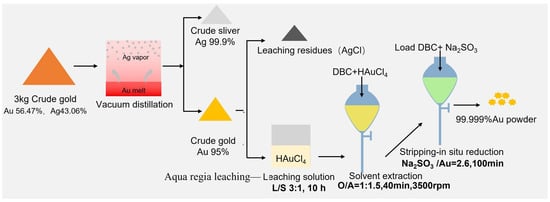
Figure 1.
Schematic of the full integrated process for preparing high-purity gold from Au–Ag alloy Feedstocks.
2.2. Experimental Principle and Equipment
The overall refining process comprises vacuum distillation for Ag removal, aqua regia dissolution of the gold-rich residue, solvent extraction using DBC, Na2SO3-assisted reduction and back-extraction, followed by filtration and acid washing to obtain 5N high-purity gold powder.
Vacuum distillation for Ag removal: Vacuum distillation was used to remove Ag from Au–Ag alloy feedstocks. This method is based on the principle that Ag has a significantly higher vapor pressure than gold at elevated temperatures under vacuum conditions, enabling its preferential evaporation and separation. The saturated vapor pressure is calculated using the following formula: , where denotes the saturated vapor pressure, Pa; T denotes the temperature, K; and A, B, C, and D denote the evaporation constants. Figure 2 shows the calculated saturated vapor pressures of Au and Ag at 1773 K. The saturated vapor pressure of Ag is 391 times higher than that of Au, making it significantly more volatile during evaporation processes, while Au remains in the distilled residue. According to our previous prediction model of vacuum distillation-based separation of gold and silver alloys, the alloy was heated to 1773 K under a vacuum of about 10 Pa. At this temperature and pressure, Ag evaporates while Au remains in the residue [22]. After 120 min of distillation, most of the Ag was removed. The Au retained in the distilled residue was used as the feed material for subsequent aqua regia dissolution.
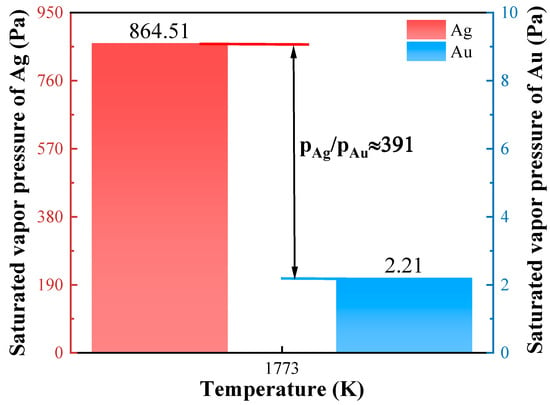
Figure 2.
Saturated vapor pressures of Au and Ag at 1773 K.
Gold leaching by aqua regia: Gold separation was carried out at room temperature using aqua regia as the treatment reagent. Aqua regia was prepared by mixing concentrated HNO3 and concentrated HCl in a volume of 1:3. The treated aqua regia containing gold was allowed to stand and settle, after which the supernatant was siphoned off for extraction. In this step, silver impurities were removed via silver chloride precipitation, and gold and copper were dissolved in aqua regia. The reaction equations of this process are shown in Equations (1)–(3).
Solvent extraction: Dibutylcarbinol (DBC) was used as the organic phase extractant, and the gold-containing solution was extracted at room temperature through 5 extraction stages. The organic phase (DBC) and the gold-containing aqueous phase were thoroughly mixed with stirring, and the acidity of the feed solution was maintained at 2.5 mol L−1 H+. After extraction, the mixture was allowed to settle for 5 min and then stratified. The extraction reaction mechanism is shown in Equation (4).
Washing: A 0.5 mol L−1 HCl solution was used as the washing agent, with three washing stages conducted at room temperature. After thorough stirring, the organic phase from the extraction and the washing agent was clarified for 5 min.
Reduction and back extraction: A saturated sodium sulfite solution was used as the reducing agent to simultaneously strip and reduce Au3+ to metallic gold (Equation (5)), with the reduction temperature controlled approximately between 343 and 358 K. Then, the gold powder was filtered, acid-washed, and dried to yield 5N Au.
The used vacuum distillation experimental equipment was designed and manufactured by our laboratory, and the principle was described in our previous study [23]. The hydrometallurgical experimental equipment included a mortar and pestle, small ball mill, beaker, glass rod, constant temperature water bath, double-layer glass reaction kettle, separating funnel, filter bottle, vacuum filter, medium-speed filter paper, pH meter, and Brinell funnel. The chemical reagents used were hydrochloric acid (prepared for aqua regia and acid washing agent), nitric acid (prepared for aqua regia), sodium hydroxide (pH buffering agent), dibutyl carbitol (extractant), and sodium sulfite (stripping and reducing agent), all of which were of industrial-grade purity.
2.3. Characterization
X-ray diffraction (XRD, Rigaku SmartLab SE, Tokyo, Japan), electron probe microanalysis (EPMA, Shimadzu EPMA-1720HT, Kyoto, Japan), and X-ray photoelectron spectroscopy (XPS, Thermo Fisher, ESCALAB Xi+, Waltham, MA, USA) were employed to evaluate the phase composition and elemental distribution of the initial Au–Ag alloy. Scanning electron microscopy (SEM, Zeiss Sigma 500, Oberkochen, Germany) was performed to examine the morphology and size characteristics of the final high-purity gold powder. The content of Au in the initial material and distilled residues was determined via a fire assay according to the Chinese nonferrous metal industry standard YS/T 3027-2017 [24]. The gold content in the distilled volatiles and the element content in the solution were analyzed using an inductively coupled plasma spectrometer (ICP-OES, Agilent 7700, Santa Clara, CA, USA).
3. Results and Discussion
3.1. Ag Removal During Vacuum Distillation
The characterization result of the phase composition and the valence state analysis of the initial Au–Ag alloy is shown in Figure 3a–c. The initial feedstocks predominantly contained Au and Ag in the metallic form, as confirmed with XRD and XPS analyses, with no detectable intermetallic compounds that could hinder separation during vacuum distillation. In addition, as shown in the Au–Ag binary phase diagram presented in Figure 3d, Au and Ag form a completely solid solution over the entire composition range. Therefore, the alloy is in a fully liquid state at the processing temperature, ensuring the homogeneous composition and uniform evaporation of silver from the melt. The EPMA elemental characterization results are shown in Figure 4, and they confirm that Au and Ag are uniformly distributed in the crude feedstock, without any obvious enrichment or segregation, and the composition is consistent.
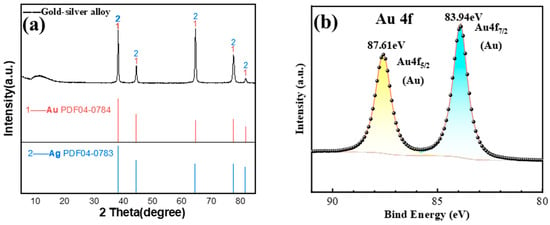
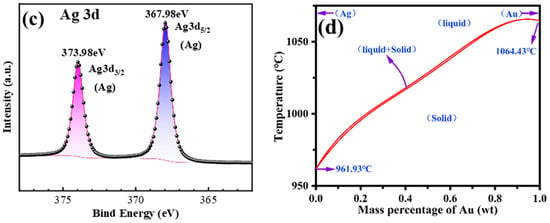
Figure 3.
Characterization of the initial feedstock: (a) XRD pattern; (b,c) XPS spectra; (d) Au–Ag binary phase diagram.
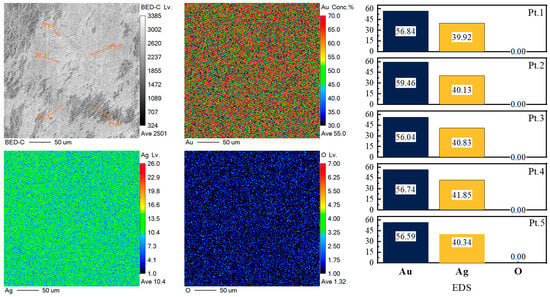
Figure 4.
EPMA elemental mapping distribution and EDS of the initial feedstock.
The experimental results of vacuum distillation of crude feedstocks are shown in Table 1. These results show that the volatile fraction contained 99.47% Ag and only 0.02% Au, confirming highly selective silver removal with negligible gold loss. Au purity in the residue increased from 56.49% to 94.76%, while Ag decreased from 43.06% to 5.17%, corresponding to a 1.68-fold enrichment of gold in a single step. The direct gold recovery rate reached 99.989%, meaning less than 0.011% Au was lost. This high selectivity results from the large vapor-pressure gap between Au and Ag under high-temperature vacuum, enabling effective Ag removal without co-evaporating Au. The low-silver residue is suitable for efficient aqua regia leaching in the next stage.

Table 1.
Experimental results and mass balance of the vacuum distillation process.
3.2. Optimization of Process Parameters for Aqua Regia Dissolution of Gold
In the aqua regia dissolution of gold stage, the effects of the liquid-to-solid ratio between aqua regia and distilled residual gold, and the settling time of aqua regia after dissolution, on the efficiency of gold purification were primarily investigated.
3.2.1. Effect of Liquid-to-Solid Ratio on Au Leaching
The liquid-to-solid mass ratios of 6:1, 4:1, 3:1, and 2:1 were assessed in the gold separation experiments, with the aqua regia volume fixed at 1 L (density:1.2 g/mL). The effect of the liquid-to-solid ratio on the gold leaching rate is shown in Table 2. The gold leaching rate gradually decreases with the increase in liquid-to-solid ratio, remaining above 97% in all cases. The mass of gold remaining in the filter residue also decreases as the liquid-to-solid ratio increases. The settling speed and the concentration of gold-containing solution should not be too high during industrial production; excessive liquid-to-solid ratios increase acid consumption and dilute the leachate, which can slow down downstream processing. Considering both efficiency and cost, a ratio of 3:1 was selected as optimal for subsequent experiments.

Table 2.
Gold separation at different liquid-to-solid ratios during the aqua regia leaching stage.
3.2.2. Effect of Liquid–Solid Ratio on Settling Time in Ag Removal
The settling process primarily targets the removal of the impurity element Ag. As shown in Figure 5, the silver content of the leach solution after gold treatment with aqua regia is initially higher, i.e., 0.156%. With the extension of the settling time, the silver content gradually decreases. When the settling time reaches 10 h, the silver content in the aqua regia solution is reduced to 0.053%, and further increasing the settling time does not improve silver removal. This is because the Ag in the aqua regia treatment is removed in the form of AgCl precipitate. The extended settling time promotes the complete reaction between Cl− and Ag impurities, and some of the partially reacted Ag is also removed as a precipitate. Therefore, a 10 h settling time was adopted for balancing impurity removal with production efficiency.
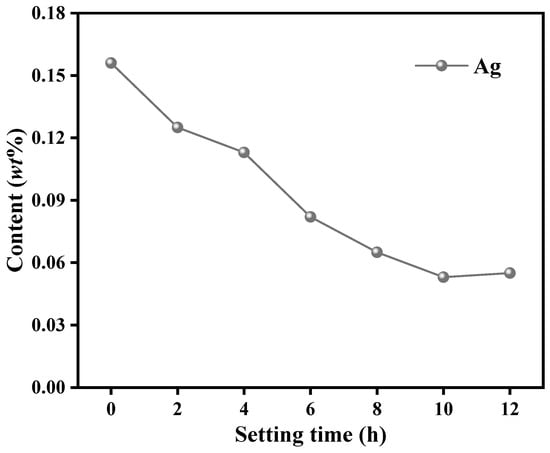
Figure 5.
Variation in Ag content in aqua regia with increasing setting time.
3.3. Optimization of Solvent Extraction Process
The Au content in aqua regia was controlled at 35 g/L by adding a diluent before extraction. The effects of phase ratio (O/A), extraction time, and rotational speed on impurity removal were examined separately.
3.3.1. Effect of Phase Ratio (O/A)
The phase ratio (O/A) refers to the volume ratio between the organic phase (O) to the aqueous phase (A) during the extraction process. Figure 6 shows the effect of the phase ratio on the concentrations of Au and impurity elements (Ag, Fe, Cu) in the extracted organic phase and the raffinate, respectively. As shown in Figure 6a, when the O/A ratio decreased from 1:1 to 1:3, the Au concentration in the organic phase decreased from 34.92 g/L to 32.11 g/L, whereas the impurity levels of Ag, Fe, and Cu increased from 0.05 mg/L, 0.03 mg/L, and 0.008 mg/L to 0.08 mg/L, 0.042 mg/L, and 0.086 mg/L, respectively. Correspondingly, the Au concentration in the raffinate increased from 1.16 mg/L to 10.52 mg/L, as shown in Figure 6b. These results demonstrate that a higher O/A ratio increases the availability of unoccupied active sites in DBC, thereby enhancing the transfer rate of AuCl4− from the aqueous phase to the organic phase. Since the extraction process is governed by dynamic equilibrium, increasing the O/A ratio also expands the interfacial contact area between the organic phase and the aqueous AuCl4−. At lower organic phase ratios, insufficient phase mixing may occur, resulting in incomplete contact between Au and the extractant in certain regions, which adversely affects mass transfer efficiency. Consequently, a higher O/A ratio shifts the extraction equilibrium toward the organic phase, improving Au extraction efficiency. However, an excessively high phase ratio increases solution viscosity, potentially inducing emulsification and reducing extraction efficiency. Additionally, higher organic phase consumption increases production costs. Notably, when comparing phase ratios of 1:1 and 1:1.5, the Au concentrations in the organic phase were nearly identical (34.92 g/L vs. 34.81 g/L), indicating diminishing returns in extraction efficiency with further increases in the O/A ratio. Therefore, an optimal phase ratio of 1:1.5 was selected for industrial applications, achieving a Au extraction efficiency of 99.46%.

Figure 6.
Effects of the O/A ratio on the metal content in (a) the extraction phase and (b) the raffinate during extraction.
3.3.2. Effect of Extraction Time
Extraction time significantly affects gold extraction efficiency. An insufficient extraction time may lead to incomplete recovery, whereas an excessive extraction time can increase energy consumption and the risk of side reactions. Under fixed conditions (extraction temperature: 298 K; phase ratio O/A: 1:1.5), the effect of extraction time on the concentrations of Au and impurity elements (Ag, Fe, Cu) in both the organic phase and raffinate was investigated, as illustrated in Figure 7.
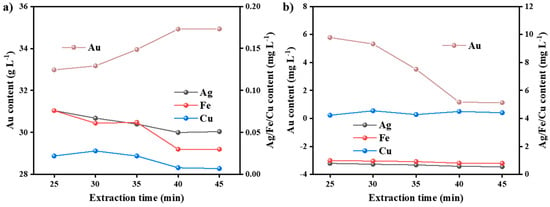
Figure 7.
Effects of extraction time on the metal content in (a) the extraction phase and (b) the raffinate during extraction.
During the initial stage of extraction, the high concentration of gold ions in the aqueous phase provides a strong mass transfer driving force, resulting in rapid extraction kinetics. As extraction proceeds, the sustained high gold concentration in the aqueous phase, coupled with adequate contact between the two phases, further enhances mass transfer and increases the extraction rate, leading to a sharp increase in Au recovery. However, with prolonged extraction time, the gold ion concentration in the aqueous phase gradually decreases, reducing the mass transfer driving force and slowing the extraction kinetics. Consequently, the rate of efficiency improvement diminishes. After 40 min of extraction, the Au extraction efficiency stabilizes, indicating that the system has reached dynamic equilibrium. At this point, the gold concentrations in the organic and aqueous phases remain nearly constant at 34.92 g/L and 1.16 mg/L, respectively, with no further significant changes. Additionally, the concentrations of impurity elements (Fe, Cu, Ag) in the organic phase decrease over time due to the relatively low selectivity of DBC toward these metals. As the Au loading in the organic phase increases, some impurities may be displaced and re-dissolved into the aqueous phase.
3.3.3. Impact of Rotational Speed
The centrifugation speed is a critical operational parameter in gold extraction, significantly influencing phase separation efficiency, mass transfer kinetics, and overall gold recovery. This section investigates the impact of centrifugation speed on the concentrations of Au and impurity elements (Ag, Fe, Cu) in both the organic and aqueous phases under controlled conditions (temperature: 298 K; phase ratio O/A: 1:1.5; extraction time: 40 min), as shown in Figure 8.

Figure 8.
Effects of rotation speed on the metal content in (a) the extraction phase and (b) the raffinate during extraction.
At lower centrifugation speeds, incomplete phase separation may lead to phase entrainment, resulting in gold loss in the aqueous phase and reduced extraction efficiency. As the centrifugation speed increases, phase separation improves, minimizing entrainment and enhancing the interfacial contact area between the organic and aqueous phases. This accelerates the mass transfer of AuCl4−, resulting in a gradual increase in gold extraction efficiency. As shown in Figure 8a, increasing the centrifugation speed from 2000× g rpm to 3500× g rpm raises the Au concentration in the organic phase from 32.56 g L−1 to 34.92 g L−1. However, the residual Au in the raffinate decreases to 1.16 mg L−1, as shown in Figure 8b. Beyond 3500× g rpm, the Au concentration in the organic phase shows negligible improvement (34.95 g L−1), indicating that the extraction kinetics are no longer controlled by mass transfer but rather by thermodynamic factors such as temperature, concentration, and reaction time. Excessive centrifugation speeds may lead to increased energy consumption and cause potential emulsification, which adversely affects separation efficiency. Notably, as DBC exhibits high selectivity for AuCl4− in aqua regia solutions, increasing the centrifugation speed not only enhances gold recovery but also reduces the co-extraction of impurities (Ag, Fe, Cu), further improving the purity of the extracted gold. A high centrifugation speed also reduced the co-extraction of Ag, Fe, and Cu. Centrifugation speeds above 3500× g rpm may increase cost and risk emulsification; thus, 3500× g rpm was selected for industrial use.
3.4. Optimization of Reverse Extraction and Reduction Process Parameters
Unlike conventional extraction–purification methods, sodium sulfite (Na2SO3) presents a unique dual functionality during the stripping process. While AuCl4− is effectively back-extracted from the DBC organic phase, the reducing sulfite ions (SO32−) simultaneously undergo a redox reaction with AuCl4− to directly precipitate elemental gold. This integrated stripping—reduction mechanism has technical advantages such as high efficiency, excellent selectivity, and environmental benefits, and its comprehensive cost of reagents is lower than that of other reduction mechanisms, resulting in good economic benefits.
3.4.1. Effect of Na2SO3 Dosage
The effect of Na2SO3 concentration on the residual gold concentration in the organic phase during the stripping process is shown in Figure 9. The results demonstrate that increasing the Na2SO3 concentration significantly promotes the forward reaction equilibrium, thereby enhancing the stripping efficiency. Notably, when the Na2SO3 concentration reached 2.6 and 2.8 times the gold content in the loaded organic phase, the residual Au concentrations in the organic phase decreased to 14.33 mg L−1 and 14.32 mg L−1, respectively, achieving remarkable stripping efficiencies exceeding 99.9%. These findings indicate that the optimal Na2SO3 concentration can effectively drive the stripping reaction to near completion while maintaining excellent process efficiency.
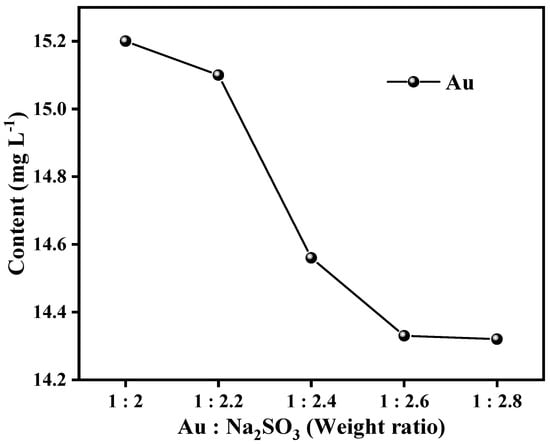
Figure 9.
Effects of Na2SO3 amount on the Au content in the organic phase after stripping.
3.4.2. Effect of Stripping Extraction/Reduction Time
Figure 10 shows the effect of reverse extraction/reduction time on the residual gold concentration in the organic phase. The results show that an appropriate extension of the stripping duration enhances stripping efficiency and reduces the Au content in the organic phase. When the stripping time reaches 100 min, the residual Au concentration decreases to 14.32 mg L−1, with only a marginal change to 14.25 mg L−1 observed upon extending the duration to 120 min. This minimal variation indicates that the stripping/reduction system approaches equilibrium after 100 min, and a prolonged contact time may increase the risk of side reactions without significant improvements in efficiency. Consequently, the optimal stripping/reduction duration is determined to be 100 min.
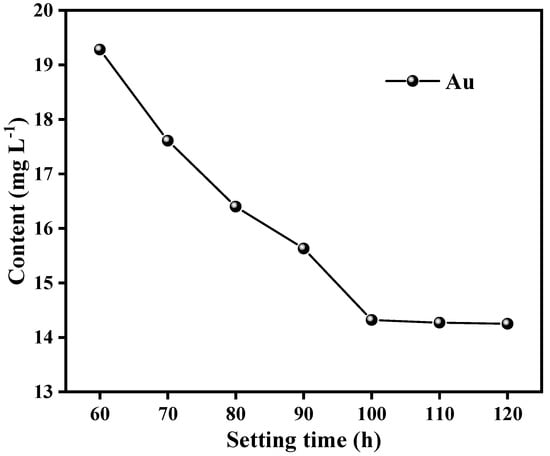
Figure 10.
Effects of stripping time on the Au content in the organic phase after stripping.
3.4.3. Analysis of Removal of Typical Impurity Elements
An analysis was conducted on the distribution and removal of elements such as gold, silver, copper, and iron throughout the entire process. The results as shown in Table 3, demonstrated that vacuum distillation can effectively remove trace silver from high-silver crude gold raw materials, and the reverse extraction in situ reduction process can effectively avoid the reduction in impurity elements, selectively recover the precious metal gold, and achieve the preparation of high-purity products. The direct yield of gold in the entire process was 99.67%.

Table 3.
Typical element distribution results for each process.
3.5. Comparative Evaluation of Proposed Process with Current Refining Processes
In summary, the following optimized process parameters were obtained with systematic investigation: (1) vacuum distillation at 10 Pa, with 1773 K held for 120 min, achieves a direct gold recovery rate exceeding 99.98%, with over 92.84% of silver being removed; (2) aqua regia treatment with a liquid-to-solid ratio of 3:1 followed by a 10 h settling time has a gold dissolution efficiency exceeding 99%; (3) extraction at an O/A phase ratio of 1:1.5 and 3500 rpm for 40 min exhibits a gold extraction efficiency of 99.46%; and (4) optimal stripping uses Na2SO3 at a 2.6 times higher concentration than that of gold in the organic phase for 100 min. Under the optimized conditions, the process consistently produces >99.999% Au with impurities fully meeting 5N standards, demonstrating both technical superiority and industrial applicability; the results are shown in Table 4. The SEM images in Figure 11 showed that the gold powder had a porous structure composed of loosely aggregated particles, with smooth surfaces and uniform size distribution, indicating high surface area and good morphology control.

Table 4.
Impurity element content in the gold powder product compared with the AU99999 standard limits.

Figure 11.
SEM micrograph of the synthesized 5N high-purity gold powder.
Table 5 clearly shows the advantages of the proposed comprehensive refining process compared with traditional methods. The pyrometallurgy, chemical refining, and aqua regia leaching–solvent extraction processes require a high number of raw materials, and their direct yield of gold is low, and the obtained gold is dispersed in the by-products of these processes. The production cycle of electrolysis process and aqua regia leaching–solvent extraction process is more than 10 days, and the backlog of precious metals is serious, and a large quantity of highly acidic waste liquid is produced. The proposed process uses vacuum distillation technology to improve the applicability of raw materials, and can treat medium-grade gold and silver alloys; the production cycle of vacuum distillation process is about 2 h, which is only one-third of that of pyrometallurgical oxidation refining, and its energy consumption is only about one-fifth of that of pyrometallurgical refining. Moreover, due to the early removal of most of the silver in the crude gold raw material, the reagent consumption in the aqua regia leaching and extraction process is also 40% lesser than that of the conventional wet process. Combined with the solvent extraction process, it can achieve ultra-high purity (>99.999%) and an excellent recovery rate (>99.98%), which greatly shortens the production cycle. This technology achieves the selective separation of silver using vacuum distillation, the high-efficiency dissolution of gold with hydrometallurgy, and gold purification using solvent extraction, combined with Na2SO3 in the situ stripping–reduction process, considering both technological efficiency and environmental sustainability. These characteristics, together with the advantages of low reagent consumption and low harmful emissions, make this process highly competitive in the field of large-scale high-purity gold production.

Table 5.
Comparison of the proposed process with conventional gold refining methods.
4. Conclusions
An integrated vacuum distillation–hydrometallurgical separation–solvent extraction process was developed in this study to produce high-purity gold from Au–Ag alloy feed-stocks. The systematic optimization of key operational parameters identified the following optimal conditions: (1) vacuum distillation at 10 Pa, with 1773 K held for 120 min, achieves a direct gold recovery rate exceeding 99.98%, with over 92.84% of silver being removed; (2) aqua regia digestion at a liquid-to-solid ratio of 3:1 followed by a 10 h settling time achieved over 99% gold dissolution efficiency; (3) extraction under optimized conditions (O/A phase ratio: 1:1.5; centrifugation speed: 3500 rpm; contact time: 40 min) yielded 99.46% gold recovery; and (4) stripping using Na2SO3 at 2.6 times the stoichiometric requirement for 100 min proved most effective. The implemented process consistently produced gold power with exceptional purity (>99.999% Au) and impurity levels meeting high-purity gold specifications. Notably, the use of vacuum distillation technology effectively removes silver from crude gold, overcoming the limitation of silver content in raw materials of aqua regia dissolution and significantly expanding the applicability of raw materials. The innovative use of Na2SO3 as a dual-function reagent—serving as both a stripping and reducing agent—significantly simplified the process flow while reducing operational costs. The combined advantages of low raw material requirements, high efficiency, cost-effectiveness, and environmental friendliness position vacuum distillation technology as a promising alternative to conventional gold refining methods.
Author Contributions
Conceptualization, W.W.; Methodology, G.Z.; Validation, W.W.; Investigation, W.W.; Data curation, W.W. and G.Z.; Writing—original draft, W.W.; Writing—review and editing, G.Z.; Visualization, W.W.; Funding acquisition, G.Z. All authors have read and agreed to the published version of the manuscript.
Funding
This project was funded by the Yunnan Science and Technology Plan Project (202301AU070183) and the National Natural Science Foundation of China (52274352). The authors sincerely acknowledge Wu Weiming for providing the Education Fund for Peng Cheng Shang Xue to support Guozheng Zha in carrying out this research.
Data Availability Statement
The original contributions presented in this study are included in the article. Further inquiries can be directed to the corresponding author.
Conflicts of Interest
Author Weihuang Wu was employed by the company Zijin Mining Group Gold Smelting Co., Ltd. The remaining author declare that the research was conducted in the absence of any commercial or financial relationships that could be construed as a potential conflict of interest.
References
- Coetzee, L.L.; Theron, S.J.; Martin, G.J.; Merwe, J.-D.V.D.; Stanek, T.A. Modern Gold Deportments and Its Application to Industry. Miner. Eng. 2011, 24, 565–575. [Google Scholar] [CrossRef]
- Dheyab, M.A.; Aziz, A.A.; Moradi Khaniabadi, P.; Jameel, M.S.; Oladzadabbasabadi, N.; Mohammed, S.A.; Abdullah, R.S.; Mehrdel, B. Monodisperse Gold Nanoparticles: A Review on Synthesis and Their Application in Modern Medicine. Int. J. Mol. Sci. 2022, 23, 7400. [Google Scholar] [CrossRef]
- Jha, M.K.; Gupta, D.; Lee, J.; Kumar, V.; Jeong, J. Solvent Extraction of Platinum Using Amine Based Extractants in Different Solutions: A Review. Hydrometallurgy 2014, 142, 60–69. [Google Scholar] [CrossRef]
- Yamada, M.; Rajiv Gandhi, M.; Kaneta, Y.; Kimura, N.; Katagiri, H. Thiodiphenol-Based n-Dialkylamino Extractants for Selective Platinum Group Metal Separation from Automotive Catalysts. Ind. Eng. Chem. Res. 2018, 57, 1361–1369. [Google Scholar] [CrossRef]
- GB/T 25933-2010; High Purity Gold. Standardization Administration of China: Beijing, China, 2010.
- Guo, Z.; Fan, X.; Liu, L.; Bian, Z.; Gu, C.; Zhang, Y.; Gu, N.; Yang, D.; Zhang, J. Achieving high-purity colloidal gold nanoprisms and their application as biosensing platforms. J. Colloid Interface Sci. 2010, 348, 29–36. [Google Scholar] [CrossRef] [PubMed]
- Neto, I.F.; Soares, H.M. Simple and near-zero-waste processing for recycling gold at a high purity level from waste printed circuit boards. Waste Manag. 2021, 135, 90–97. [Google Scholar] [CrossRef] [PubMed]
- Birloaga, I.; Vegliò, F. An Innovative Hybrid Hydrometallurgical Approach for Precious Metals Recovery from Secondary Resources. J. Environ. Manag. 2022, 307, 114567. [Google Scholar] [CrossRef] [PubMed]
- Xiang, Z.; Wang, S.; Yang, Y.; Xin, X. Equilibrium, Thermodynamics and Kinetics Study on Au(III) Extraction by Gemini Surfactant with Different Spacer Length. Sep. Sci. Technol. 2019, 54, 985–995. [Google Scholar] [CrossRef]
- Kondo, K.; Sawada, M.; Matsumoto, M. Adsorption and Separation of Palladium and Platinum with Microcapsules Containing Tri-n-Octylamine Hydrochloride. J. Water Process Eng. 2014, 1, 115–120. [Google Scholar] [CrossRef]
- Panda, R.; Dinkar, O.S.; Jha, M.K.; Pathak, D.D. Recycling of Gold from Waste Electronic Components of Devices. Korean J. Chem. Eng. 2020, 37, 111–119. [Google Scholar] [CrossRef]
- Kyriakakis, G. Extraction of Gold from Platinum Group Metal (PGM) Ores. In Developments in Mineral Processing; Elsevier: Amsterdam, The Netherlands, 2005; Volume 15, pp. 897–917. ISBN 978-0-444-51730-2. [Google Scholar]
- Ji, H.; Guo, S.; Gao, L.; Yang, L.; Yan, H.; Zeng, H. Revolutionizing Titanium Production: A Comprehensive Review of Thermochemical and Molten Salt Electrolysis Processes. Int. J. Miner. Metall. Mater. 2025; accepted manuscript. [Google Scholar]
- Nose, K.; Okabe, T.H. Platinum Group Metals Production. In Treatise on Process Metallurgy; Elsevier: Amsterdam, The Netherlands, 2024; pp. 751–770. ISBN 978-0-323-85373-6. [Google Scholar]
- Li, W.; Sun, N.; Stoner, B.; Jiang, X.; Lu, X.; Rogers, R.D. Rapid Dissolution of Lignocellulosic Biomass in Ionic Liquids Using Temperatures above the Glass Transition of Lignin. Green Chem. 2011, 13, 2038. [Google Scholar] [CrossRef]
- Armendariz, V.; Herrera, I.; Peralta-Videa, J.R.; Jose-Yacamanet, M.; Troiani, H.; Santiago, P.; Gardea-Torresdey, J.L. Size controlled gold nanoparticle formation by Avena sativa biomass: Use of plants in nanobiotechnology. J. Nanopart. Res. 2004, 6, 377–382. [Google Scholar] [CrossRef]
- Gamez, G.; Gardea-Torresdey, J.L.; Tiemann, K.J.; Parsons, J.; Dokken, K.; Yacaman, M.J. Recovery of gold (III) from multi-elemental solutions by alfalfa biomass. Adv. Environ. Res. 2003, 7, 563–571. [Google Scholar] [CrossRef]
- Reith, F.; Zammit, C.M.; Rogers, S.L.; McPhail, D.C.; Brugger, J. Potential utilisation of micro-organisms in gold processing: A review. Miner. Process. Extr. Metall. 2012, 121, 251–260. [Google Scholar] [CrossRef]
- Sharma, R.; Suhendra, N.F.; Jung, S.H.; Lee, H.I. Gold recovery at ultra-high purity from electronic waste using selective polymeric film. Chem. Eng. J. 2023, 451, 138506. [Google Scholar] [CrossRef]
- Xiong, Q.; Yuan, Z.; Zhang, Y.; Chen, Z.; Wei, K.; Ma, W. A new approach for separating copper, tin, and lead from photo-voltaic ribbon wastes. Sol. Energy 2025, 299, 113810. [Google Scholar] [CrossRef]
- Yi, X.; Qi, Y.; Li, F.; Shu, J.; Sun, Z.; Sun, S.; Chen, M.; Pu, S. Effect of electrolyte reuse on metal recovery from waste CPU slots by slurry electrolysis. Waste Manag. 2019, 95, 370–376. [Google Scholar] [CrossRef]
- Wu, W.; Yang, Y.; Qiu, H.; He, L.; Zha, G.; Jiang, W.; Xu, B.; Yang, B.; Cao, X. Sustainable strategy for removing Ag impurities from crude gold via a vacuum distillation process to produce a 4N gold product. J. Clean. Prod. 2025, 500, 145248. [Google Scholar] [CrossRef]
- Yi, J.; Zha, G.; Huang, D.; Kong, X.; Yang, B.; Liu, D.; Xu, B. Effective Separation and Recovery of Valuable Metals from High Value-Added Lead Anode Slime by Sustainable Vacuum Distillation. J. Clean. Prod. 2021, 319, 128731. [Google Scholar] [CrossRef]
- YS/T 3027-2017; Chemical Analysis Methods for Crude Gold. Ministry of Industry and Information Technology of the People’s Republic of China: Beijing, China, 2017.
- Corti, C.W. Recovery and Refining of Gold Jewellery Scraps and Wastes. In The Santa Fe Symposium on Jewelry Manufacturing Technology; Met-Chem Research: Albuquerque, NM, USA, 2002; pp. 1–20. [Google Scholar]
- Mahyapour, H.; Mohammadnejad, S. Optimization of the Operating Parameters in Gold Electro-Refining. Miner. Eng. 2022, 186, 107738. [Google Scholar] [CrossRef]
- Feather, A.; Sole, K.C.; Bryson, L.J. Gold Refining by Solvent Extraction—The Minataur Process. J. S. Afr. Inst. Min. Metall. 1997, 97, 169–173. [Google Scholar]
Disclaimer/Publisher’s Note: The statements, opinions and data contained in all publications are solely those of the individual author(s) and contributor(s) and not of MDPI and/or the editor(s). MDPI and/or the editor(s) disclaim responsibility for any injury to people or property resulting from any ideas, methods, instructions or products referred to in the content. |
© 2025 by the authors. Licensee MDPI, Basel, Switzerland. This article is an open access article distributed under the terms and conditions of the Creative Commons Attribution (CC BY) license (https://creativecommons.org/licenses/by/4.0/).